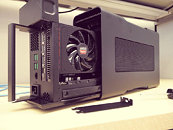- Joined
- Oct 9, 2007
- Messages
- 47,511 (7.49/day)
- Location
- Hyderabad, India
| System Name | RBMK-1000 |
|---|---|
| Processor | AMD Ryzen 7 5700G |
| Motherboard | ASUS ROG Strix B450-E Gaming |
| Cooling | DeepCool Gammax L240 V2 |
| Memory | 2x 8GB G.Skill Sniper X |
| Video Card(s) | Palit GeForce RTX 2080 SUPER GameRock |
| Storage | Western Digital Black NVMe 512GB |
| Display(s) | BenQ 1440p 60 Hz 27-inch |
| Case | Corsair Carbide 100R |
| Audio Device(s) | ASUS SupremeFX S1220A |
| Power Supply | Cooler Master MWE Gold 650W |
| Mouse | ASUS ROG Strix Impact |
| Keyboard | Gamdias Hermes E2 |
| Software | Windows 11 Pro |
AMD is working on a standardized external graphics solution for notebooks. This solution will allow people with ultra-thin notebooks to enjoy the mobility served up by frugal, mainstream hardware; as well as high-end gaming, with the graphics card plugged in at home. It also probably gives AMD greater control over design and cooling solutions. Unlike a mobile GPU that sits inside your notebook, and makes it bulky due to additional cooling and power requirements, an external graphics card sits on your desk, sipping on wall socket power.
AMD's external graphics solution isn't necessarily an AMD-branded piece of hardware, but rather an open specification for notebook vendors to follow. AMD will merely provide the GPUs and software ecosystem that makes the solution truly universal and plug-n-play, with "standardized connectors, cables, drivers, and OS support." Such a graphics card will interface with just any notebook with a high-speed interface (eg: Thunderbolt). Its drivers will make it crunch your games, while sending back output to your notebook's display, over the same connection. This gives you the mobility of an ultra-thin notebook. You should also be able to plug this into your work's boring Dell desktop, or any SFF ITX box. Pictured below is a Razer Core graphics solution embedding a Radeon R9 Nano. Other examples include MSI Gaming Dock and Alienware Graphics Amplifier.

View at TechPowerUp Main Site
AMD's external graphics solution isn't necessarily an AMD-branded piece of hardware, but rather an open specification for notebook vendors to follow. AMD will merely provide the GPUs and software ecosystem that makes the solution truly universal and plug-n-play, with "standardized connectors, cables, drivers, and OS support." Such a graphics card will interface with just any notebook with a high-speed interface (eg: Thunderbolt). Its drivers will make it crunch your games, while sending back output to your notebook's display, over the same connection. This gives you the mobility of an ultra-thin notebook. You should also be able to plug this into your work's boring Dell desktop, or any SFF ITX box. Pictured below is a Razer Core graphics solution embedding a Radeon R9 Nano. Other examples include MSI Gaming Dock and Alienware Graphics Amplifier.

View at TechPowerUp Main Site






